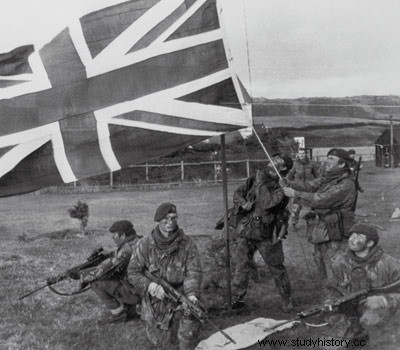
In Port Darwin, contact was established on the morning of May 28 by special forces commandos, helicoptered to the opposing lines to "feel" the enemy. During the day, this vanguard was joined by the bulk of the 2nd Paratroopers. But it was not until the next day, before dawn, that a battalion of paratroopers launched an attack on the positions held by the Argentines. Well buried, they will fight for 14 hours before surrendering to an enemy certainly inferior in number but more seasoned and supported from a distance by the artillery of the Royal Navy coming in cover. Result of this first battle:25 dead among the British, including Lieutenant-Colonel Herbert Jones, commanding the 600 men of the 2nd Parachute Battalion, mown down by a machine gun at the head of his troops; on the Argentinian side, the picture is even bleaker, in addition to 1,400 prisoners, more than 200 soldiers would have died in the fighting.
The day after this victory, the British paratroopers resumed their march towards Port Stanley after handing over Port Darwin and Goose Green to reinforcements from the Port San Carlos beachhead. To the north, Royal Marine units continued their advance eastward at the foot of the range of hills that stretch across the island, easily jostling the Argentine patrols and the posts of Douglas and of Teal Inlet.
During their push, the shock troops learned the good news:the 3,500 men of the 5th Infantry Brigade aboard the Queen Elisabeth II were beginning to disembark at Port San Carlos. The arrival of this unit, composed of regiments of the Scots Guards, the Welsh Guards and the famous Gurkhas, brought the strength of the British Expeditionary Force to 8,500 men. At the same time, a new chief had just arrived directly from London to direct the final phase of operations, the Battle of Port Stanley, Major General Jeremy Moore.
In the first days of June, the forward elements of the northern wing of the British forces took without much opposition Mount Kent, a height overlooking the site of Port Stanley, some twenty kilometers from the capital. For his part, Brigadier General Wilson, commanding the 5th Infantry Brigade suffered the blows of the Argentine air force in the south. At Bluff Cove, in a cove sheltering the small hamlet of Fitzroy, the Argentine Skyhawks surprised at dawn on June 8 a landing of fresh troops transported by sea from Port San Carlos. Without anti-aircraft defence, the British, subject to the law of the Argentine airmen, lost there more than 60 men
—their biggest losses since the beginning of the conflict—out of the 700 crammed into the landing craft. A setback hard felt in London, but the offensive continued with the arrival of new reinforcements, this time protected by batteries of Rapier missiles.
The advance of British troops continued on the following days of all the more easily as their Argentine adversaries were busy entrenching themselves around Port Stanley. After a few skirmishes with Argentine outposts, the two British offensive groups coming from the north and the south operated their junction on the direct outskirts of Port Stanley, successively taking all the heights surrounding the city, Mounts Harriet, Wall, Two Sisters of where their artillery began to shell the Argentine positions below. During the day of June 12, the British pressure, served by bad weather, marked time; but helicopter commandos took possession of Mount Tumbledown, less than ten kilometers from the final objective. As General Moore made contact with General Menendez in an attempt to avert too bloody a battle, artillery from both sides rained hundreds of shells and rockets on the adversary.
The next day, June 13, a Sunday, passed in anticipation of the final assault. In the impatience of the British who wanted to end it, in fear of the Argentine side where the warlike ardor of the first days had given way to defeatism. In the deafening din of the bombardments, the Argentine chaplains were more surrounded than ever, while at the outposts the British shock groups came to test the defenses of the enemy. From the afternoon, the first line of Argentine defense deployed at the western exit of Port Stanley fell back in disorder. The betting was done; General Menendez in agreement with his superiors in Buenos Aires had already negotiated the surrender of his 8,000 men to avoid a massacre.
The battle of Port Stanley, which had been prepared by both sides for weeks, did not therefore did not take place. British forces camped at the gates of the Falklands capital entered the city in the early morning of June 14, in freezing temperatures and squalls of snow. In the Argentine ranks, it was a debacle. Long lines of haggard, transfixed soldiers wandered the streets under the gaze of helpless officers. While waiting for their repatriation, they would be assembled on the airfield away from the city.
By the end of the morning, British flags had replaced the colors, blue and white, Argentinian on public buildings and General Moore urgently telegraphed Whitehall:"Mission accomplished." British order reigns in Port Stanley. God Save the Queen. »
